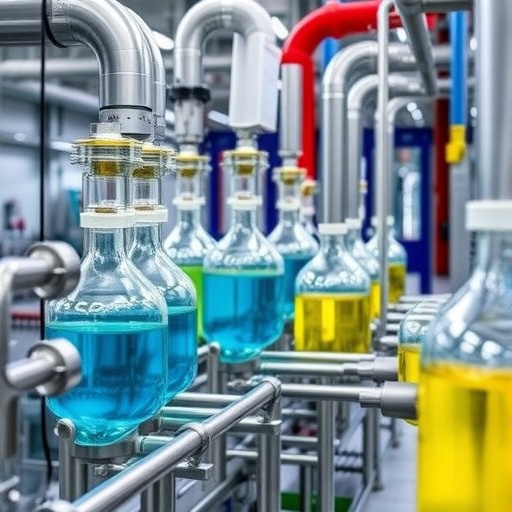Researchers from the Center for Advanced Bioenergy and Bioproducts Innovation (CABBI) have recently achieved a breakthrough in the production of succinic acid through yeast fermentation. The team, consisting of experts from the University of Illinois Urbana-Champaign and Princeton University, has successfully re-engineered the metabolic pathways of the yeast strain Issatchenkia orientalis. This innovative approach not only improves the yield of succinic acid—a vital industrial chemical used across various sectors including food, agriculture, and pharmaceuticals—but also takes significant strides toward eco-friendly production methods.
The challenges faced in yeast fermentation can be extensive, particularly related to the availability of NADH, a critical coenzyme involved in energy storage and production in cells. Efficient chemical production relies heavily on this energy currency, and ensuring its availability within the cell is paramount for maximum output. In typical yeast cells such as I. orientalis, cellular compartments can hinder this process by dispersing NADH, making it less accessible for the pathways that convert glucose to succinic acid. The research team’s innovative technique of metabolic “decompartmentalization” addresses this challenge effectively.
.adsslot_1A2YUnwOeS{ width:728px !important; height:90px !important; }
@media (max-width:1199px) { .adsslot_1A2YUnwOeS{ width:468px !important; height:60px !important; } }
@media (max-width:767px) { .adsslot_1A2YUnwOeS{ width:320px !important; height:50px !important; } }
ADVERTISEMENT
Through decompartmentalization, crucial components of the NADH production machinery have been relocated from mitochondria to the cytosol, the main area of the cell where succinic acid is synthesized. By doing so, the researchers have managed to significantly amplify the amount of available NADH where it is most needed in the cell’s main metabolic hub, resulting in enhanced succinic acid production efficiency. The implications of this advancement are notable, as it marks a substantial leap in the process’s overall yield, elevating it from 64% to an impressive 85%.
The economic ramifications of this enhanced yield are substantial and demonstrate a clear path toward commercialization. With a reduction in the minimum product selling price (MPSP) of succinic acid—from $1.30 per kilogram to just 97 cents—this research positions the bio-based approach to compete effectively in the market against its petrochemical counterparts. For industrial chemicals, even slight reductions in pricing can translate into considerable savings across the scale of production, bringing potential financial benefits to manufacturers and consumers alike.
Moving forward, the CABBI team is not only focused on succinic acid but also eyeing strategies to apply similar metabolic engineering techniques to produce other essential organic acids. One such target is 3-hydroxypropionic acid (3-HP), which is similarly significant in bioproduct manufacturing. These developments could revolutionize how various chemicals are produced, moving away from fossil fuel-derived processes and embracing more sustainable, plant-based alternatives.
Many companies are already expressing interest in scaling this technology for commercial applications, a transition that researchers anticipate could occur within the next year. The encouragement from industry stakeholders highlights the potential impact of this research in driving a more sustainable future for chemical production as part of the broader movement towards bioeconomy.
This work signifies a massive leap towards greener manufacturing processes, indicating serious advancements in bioengineering and sustainability paradigms in chemistry. As researchers continue to explore and optimize microbial strains for efficiency in production, the prospect of achieving high yields with low environmental impact remains tantalizingly close. This shift could be pivotal not just for industries reliant on succinic acid, but for the entire sector moving towards sustainable practices.
Through hard work and innovative thinking, the researchers are setting a precedent in metabolic engineering that emphasizes not only productivity but also sustainability, indicating that the future of chemical production could indeed be greener. The journey towards achieving fully sustainable and economically achievable routes for chemical synthesis presents exciting potential, with implications that resonate through various facets of society and industry.
As we anticipate the outcomes of industrial applications derived from this research, the CABBI team maintains its commitment to exploring other biochemicals derived from biomass crops. Ultimately, the implications of this work stretch far beyond mere academic interest and pave the way for practical solutions to some of our most pressing environmental challenges.
As the work unfolds and develops further, the CABBI’s ongoing commitment to collaboration and research innovation will undoubtedly continue to yield promising results in the realm of bioproducts and bioenergy, representing a hopeful trajectory towards a more sustainable future.
Subject of Research: Enhanced succinic acid production via metabolic engineering in Issatchenkia orientalis
Article Title: Decompartmentalization of the yeast mitochondrial metabolism to improve chemical production in Issatchenkia orientalis
News Publication Date: 2-Aug-2025
Web References: Link to Nature Communications Article
References: 10.1038/s41467-025-62304-w
Image Credits: Julie Wurth/CABBI
Keywords
Metabolic engineering, yeast fermentation, sustainable chemistry, succinic acid, bio-based products, ecological manufacturing, renewable resources, chemical production.
Tags: advancements in fermentation technologyCABBI research on bioproductscarbon footprint reduction in chemical processeseco-friendly chemical manufacturingenergy storage in yeast metabolisminnovative approaches to chemical synthesismetabolic engineering of yeastrenewable plant resources in chemistrysuccinic acid production methodssustainable production of industrial chemicalsvalue-added bio-based chemicalsyeast fermentation for bio-based chemicals





